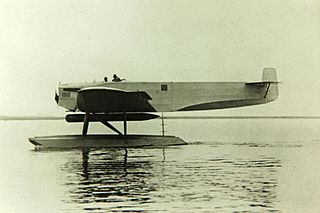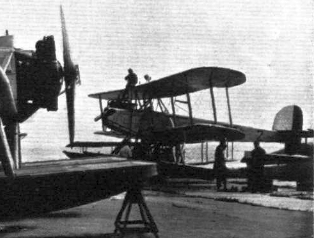Related Research Articles

The Lederlin 380L is an unconventional light aircraft developed in France in the 1960s, and marketed for homebuilding.

The Savoia-Marchetti SM.80 is a two-seat monoplane amphibian tourer, with a single, tractor engine mounted above the wing, designed in Italy in the early 1930s. The SM.80bis is a four-seat variant, powered by two pusher engines.

The Fokker T.III or T.3 was a single engine floatplane designed in the Netherlands in the early 1920s as a bomber or torpedo bomber.

The LFG Roland G.I was a large prototype single-engine biplane bomber built in Germany in 1915, during World War I. It had a single engine buried in the fuselage driving pusher configuration propellers mounted on outriggers.

The LFG V 60 was a small, single engine, tandem seat floatplane training aircraft, designed and built in Germany in the mid-1920s. About five were constructed.
The Bonomi BS.22 Alzavola was a training motor glider, intended to acquaint capable glider pilots with the characteristics of powered aircraft. The sole example was designed and built in Italy in the mid-1930s.

The Potez 35 was a twin engine bomber aircraft, designed and built in France in the late 1920s. Only one was completed.

The Caudron C.180 was an all-metal, three-engine French ten-seat passenger aircraft, flown about 1930. Only one was built.
The Landray GL.01 is a small tandem-wing, side-by-side seat sport aircraft of the Mignet Pou-du-Ciel type. Built in the mid 1970s, the single example remains active.
The Langlois JL.2 was a three-winged agricultural aircraft built in France in 1979. It failed to sell and only one was built.
The Landray GL.02 Ami Pou was a very basic, low-powered French tandem wing, single-seat sports aircraft. The only example flew in 1979.
The Landray GL.03 Pouss Pou was a small, pusher configuration tandem wing aircraft built in France in the early 1980s. Only one was completed, though it was much modified.
The Piel CP-20 Pinocchio is a single engine French sport monoplane first flown in 1951. Only two were built but one was still flying over sixty years later.
The Piel CP-40 Donald is a French homebuilt, single engine, single seat, high wing aircraft. It was first flown in the early 1950s, though the last of the three examples completed did not fly until almost forty years later.
The Caudron C.251 Et-2 was a French tandem seat, open cockpit biplane designed as an intermediate trainer and built in 1931. It did not go into production.
The Lacroix-Trussant L.T.-51 Microplan was a French, low-powered, two seat amateur-built biplane. It flew just before the outbreak of World War II. After the war it was re-engined and flew until 1953.
The Avia 50-MP was a French motor glider based on that of the Avia XV-A training glider. First flown in 1934, it was intended to introduce pilots to motor-gliders.

The Lioré et Olivier LeO H-23 was a French military flying boat, primarily intended for coastal reconnaissance, though able to carry a small bomb load. Only one was built.
The Itoh Emi 3 was the first Japanese civil passenger carrying seaplane, flown in 1917 and used for commercial demonstrations and passenger flights.
The SCAL FB.30 was a French twin boom, pusher configuration, two seat civil sport and touring aircraft designed by Antoine Bassou in the mid-1930s. Three, with different engines, were built and flown.
References
- 1 2 3 Gaillard, Pierre (1990). Les Avions Francais de 1944 à 1964. Paris: Éditions EPA. p. 75. ISBN 2-85120-350-9.